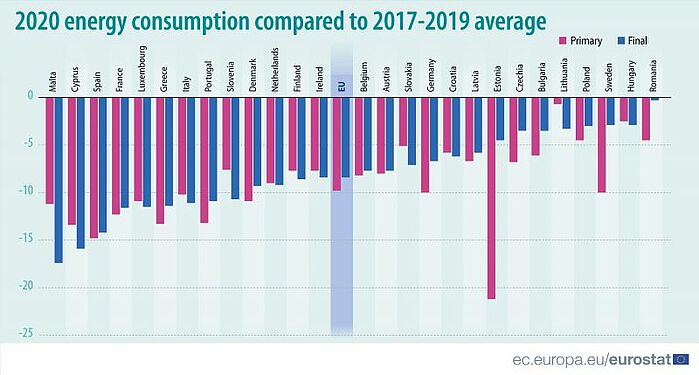The official statistical office of the EU, Eurostat, presented statistics on the dynamics of energy consumption in 2020. In addition, the data is provided in relation to the 2020 and 2030 energy objectives set by the Union. Thus, the EU-28 has committed itself to reduce energy consumption by 20% in 2020, and the 2030 binding target is to reduce energy usage to at least 32.5%. Since the United Kingdom left the Union, the energy consumption figures for 2020 and 2030 have been adjusted to reflect the situation in the 27 member states. The figures presented make the distinction between the primary energy consumption and the final energy consumption.
According to the published evaluation, such a low energy consumption in the EU as in 2020 has not been observed since 1990. Thus, primary energy consumption fell sharply to 1,236 million tons of oil equivalent (Mtoe), which is almost 6 percent better than the 2020 target. All EU member states decreased their primary energy consumption compared to the 2017-2019 average. Estonia recorded the largest decrease (-21.2%), ahead of Spain (-14.8%) and Cyprus (-13.4%). The smallest declines were registered in Lithuania (-0.7%), Hungary (-2.5%) and Romania (-4.5%). The similar overall decrease was also registered in final energy consumption. Malta (-17.4%), Cyprus (-15.9%) and Spain (-14.2%) experienced the largest drop, while Romania (-0.3%), Hungary (-2.9%) and Sweden (-2.9%) showed the smallest drop.
However, when compared to the 2030 targets, the results are almost 10 percent below the target. In addition, the low energy usage in 2020 is largely due to the unprecedented effects of the COVID-19 restrictions, so strictly speaking this year cannot be considered representative and can only be put in relation to the 2030 targets against the backdrop of the pandemic. According to 2021 trends, global energy consumption has returned to pre-pandemic levels, and the EU is unfortunately no exception. This means that the positive trends of 2020 were rather the exception, and we are much further away from the energy and climate goals set for 2030.
